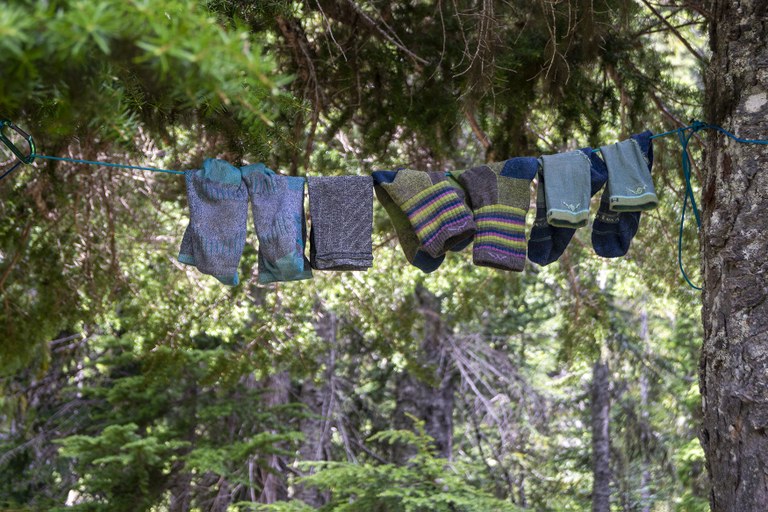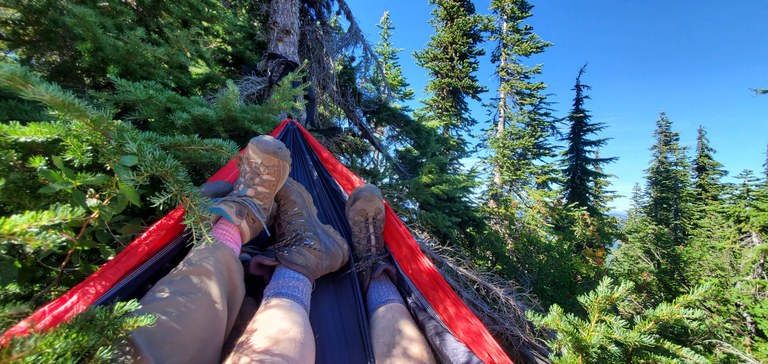 Washington Trails
Association
Washington Trails
Association
Trails for everyone, forever
Happy feet, happy hiker. The right hiking socks can make a huge difference to your day on trail. (And your time chilling in camp.) Here’s some tips to help you find a pair that works for you. By Sandra Saathoff
I have a sock obsession. I admit it. Plop me in a store and you’ll soon find me caressing the soft fuzzy socks, squeezing the cushioning and reminding myself that I have dozens of socks in my drawer and I don’t need any more. So when the opportunity came to write about hiking socks, I jumped at it — and offered to try out several pairs to determine what really works best in different scenarios.
On trail, socks are important — they aren’t just pieces of fabric. They act as a crucial barrier between your feet and your shoes or boots, protecting against blisters, hot spots and abrasions. Hiking socks provide cushioning and support, wick away moisture and regulate temperature, ensuring your feet stay dry and comfortable throughout your hiking adventures. And as many types of feet there are — that’s how many types of socks there are: short, medium, tall, different fabrics, different features. So let’s look at some of them.
Hiking socks come in a variety of heights ranging from ankle and quarter crew to three-quarter crew and full length. Why does this matter? Socks should be taller than the shoes or boots you’re wearing, so the footwear isn’t rubbing on your skin. If you wear boots, that may mean choosing a three-quarter or full-length sock. If you’re using trail runners, you could get away with a quarter crew or even a shorty running sock. Depending on the season, socks also provide protection against mosquitoes and black flies and can be treated with insect repellent. If you’re backpacking in summer, you may choose a taller sock just to keep the bugs from eating your legs. Similarly, socks can provide sun protection, and tall socks can be paired with shorts to protect more skin.

Don't forget to let your feet breathe. Photo by Heidi Walker.
Light, medium or heavy weight — depending on your preference, you can find socks in all varieties. Again, the choice is personal. Do you value a thicker cushion because your feet feel better when hiking through rocky terrain – or warmer when snowshoeing? Do you prefer a thinner sock because your trail runners have plenty of cushion and you value a quicker drying sock while you’re doing water crossings in the backcountry?
This is another feature with a lot of variability. A sock design may come with reinforced arches and ankle support or none at all. Tall compression socks provide incredible support for legs and feet, boosting blood flow, reducing leg fatigue and cramping, aiding muscle recovery and alleviating leg swelling. They can translate to a more enjoyable hiking experience for some. Spend some time looking at the options and decide what might work best for you based upon your own circumstances.
While most socks are designed with the toes all in one area, there are also socks with individual ports for each toe. These toe socks may be helpful for people who get blisters on or between their toes when wearing average socks. The toe fabric rubs against other fabric instead of toes rubbing against toes. There are also sock liners, very thin socks that go on first and are followed by your normal hiking sock. Liners provide an extra layer of fabric intended to mitigate blisters.

The right socks don't just keep your feet warm — they protect them as well. Photo by Jonathan Sandelin.
Merino wool, cotton, polyester or nylon. Merino wool offers excellent moisture wicking, odor control and temperature regulation. Synthetic blends like polyester and nylon provide durability, breathability and quick-drying capabilities. Cotton tends to absorb moisture, lose its insulating properties and can take a while to dry, so it’s not ideal on its own but is sometimes blended with synthetics for comfort.
First, determine what type of hiking you’re going to be doing — and in what season(s). You may need multiple pairs that can be swapped out during the year, depending on the conditions and your footwear. Thicker, warmer socks are ideal for cold weather, while lighter, moisture-wicking options are better suited to warm climates and summertime. During a short day hike, your feet may have different needs than on a multiday backpacking trip where you’re doing 12+ miles a day.
Once you’ve determined the type of sock you’re looking for, ensure a proper fit by choosing socks that match your shoe size and have a snug yet comfortable feel. Avoid socks that bunch up or have excess material, as they can cause blisters or discomfort.
Quality and durability are important considerations as well. Investing in a high-quality hiking sock may mean spending a little more upfront, but these socks are built to withstand the rigors of the trail over time. Some brands even come with a lifetime guarantee.
Finally, personal preference does come into play. Everyone’s feet are unique, so it’s essential to try on different brands and styles to find the ones that suit you best. Pay attention to features that matter most to you, such as cushioning, moisture wicking or reinforced toes and heels.
Investing in high-quality hiking socks is an important step toward ensuring a comfortable and enjoyable hiking experience. Socks protect your feet, provide cushioning and keep moisture at bay, reducing the risk of blisters.
By prioritizing the well-being of your feet, you can embark on your treks with confidence, knowing your feet will remain happy on trail. You may even find a new favorite sock — I did!
Part of my sock research included testing a few options I hadn’t tried before. I learned a lot — and maybe so can you! Note: I tested these in the summer — so while some may have been hot for then, they could be ideal for winter hikes.
| Brand | Style | Fabric | Features | Best Use | Notes | |
|---|---|---|---|---|---|---|
| Bombas | Light-weight | Cotton, polyester, nylon, elastone blend | Seamless toe, stay-up tech, honeycomb arch support, cushioned | Spring, fall, winter | Very comfortable, but I overheated in summer hiking | |
| Bombas | Hex Tec Perform-ance | Cotton, polyester, nylon, elastone blend | Honeycomb arch support, seamless toe, airflow venting, full cushion | Spring, fall, winter | Again comfortable, but even with the airflow venting, overheated in summer | |
| Farm to Feet | Sport, ¼ crew | Merino wool | Moisture management, ultrafine 19.5 micron yarn | Spring, summer, fall | Very comfortable, foot temperature stayed regulated all day, fast-drying | |
| Farm to Feet | Trail, ¾ crew | Merino wool | Light targeted cushion | Spring, summer, fall | Nice cushioning, very comfortable, not too hot even in 85 degree weather | |
| Smartwool | Light-weight, ¼ crew | Merino wool | Targeted cushion on heel and ankle, odor resistant | Spring, summer, fall | Very comfortable, foot temperature stayed regulated all day, fast-drying | |
| Pro Compression | Full length comp-ression | Polyester, nylon, spandex blend | Provides support for foot and calf, increases blood flow efficiency | Spring, summer, fall | Comfortable, fast-drying, legs recovered faster after workout | |
| Darn Tough | Micro crew mid-weight | Merino wool, nylon, Lycra blend | Breathable cushioning and low-profile, slouch-free 1x1 ribbing | Spring, fall, winter | Comfortable, durable sock for cooler seasons |
In the end, given my own needs, although I loved all the socks I tried in their own sweet spots, I took the PRO Compression socks on 12 days of backpacking trips and they performed well, although they were a challenge at stream crossings. Being compression socks, they are a tight fit and tough to get on wet feet. On a warm day, I put my water shoes over them and walked through, but on cooler days that wouldn’t be the best option. However, that issue was manageable and the support and recovery far outweighed the annoyance factor. As for the other socks in my trial, I’ll definitely wear them for day hikes throughout the year. I was impressed with the number of quality hiking socks available and know there were tons more I didn’t try. If you’re looking for new socks, use the flow chart at the right to help you narrow in on what you need.